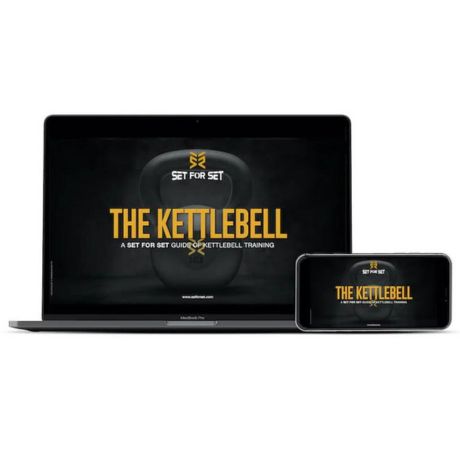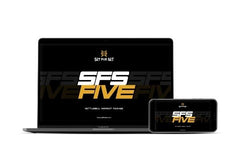Want to build powerful, horseshoe-shaped triceps using kettlebells? You’re in the right place. Below we’ll cover:
-
Triceps anatomy and function
-
Why kettlebells are great for triceps
-
The 8 best kettlebell tricep exercises
-
Programming tips for growth and definition

TRICEP ANATOMY
The triceps brachii is a three-headed muscle on the back of your upper arm, making up 60–70% of your upper arm’s mass:
-
Long Head: Largest head; originates at the scapula and crosses the shoulder joint.
-
Lateral Head: Outer upper arm; originates high on the humerus.
-
Medial Head: Underneath the long head; originates mid-humerus.
All three converge into a single tendon that inserts into the ulna near your elbow. Together, they’re responsible for elbow extension, and the long head also helps with shoulder extension and adduction.

How to Target Each Tricep Head
You can’t isolate each head entirely, but exercise angle and grip can emphasize specific areas:
-
Overhead position (180° arm angle): Stretches and targets the long head
-
Kickback or arms-behind-you positions: Also emphasize the long head
-
Overhand/neutral grips: Emphasize lateral head
-
Underhand grips: Emphasize medial head
Pro Tip: Use a variety of exercises and angles for complete development.
Related:
- Best Lateral Head Tricep Exercises
- Best Medial Head Tricep Exercises
- Best Long Head Tricep Exercises

CAN YOU USE KETTLEBELLS FOR TRICEPS?
Yes! Kettlebells work just as well as dumbbells or barbells for triceps—plus, they offer unique benefits:
-
More hand/grip variety: Horn, top handle, or bell
-
Variable load placement: Above, beside, or under wrist
-
Instability factor: Engages stabilizers for greater tension
While dumbbells may allow for heavier loads, kettlebells introduce novel stimuli and can help target weak points.
WHAT KETTLEBELL EXERCISES TARGET THE TRICEPS?
Here are the 8 kettlebell tricep exercises that we are going to demo for you below:
- Bell-Grip Overhead Extension
- Tricep Dip
- Tate Press
- Tricep Kickback
- Skull Crusher
- Close-Grip Floor Press
- Single Arm Overhead Extension
- Push Up On The Ball
Before we get into the exercises, we want to go over what makes kettlebell triceps exercises special and some best practices for getting the most out of the exercises.

Triceps Training Guidelines
-
Train Triceps Twice Weekly: 16–20 total sets per week
-
Compound Movements: 6–12 reps (e.g., dips, close-grip presses)
-
Isolation Movements: 8–20 reps (e.g., skull crushers, kickbacks)
-
Progressive Overload: Increase reps, load, range of motion, or intensity over time
Split routines like Push/Pull/Legs or Upper/Lower allow for optimal training frequency.

Containing 41 exercises, 10 complexes, and an 8 week program that you can follow. We've created the only guide you'll need to master the kettlebell and bring your training to the next level...
8 KETTLEBELL TRICEP EXERCISES
- Bell-Grip Overhead Extension
- Tricep Dip
- Tate Press
- Tricep Kickback
- Skull Crusher
- Close-Grip Floor Press
- Single Arm Overhead Extension
- Push Up On The Bell
Let's look closely at each exercise. We are going to make a point to mention which heads are emphasized for each exercise and the benefits as a whole.
1. Kettlebell Bell-Grip Overhead Extension

-
Target: Long head (also lateral head via forearm rotation)
-
Why it works: Holding the kettlebell by the bell instead of the handle places the load behind the head, increasing tension on the triceps. The overhead position places a deep stretch on the long head of the triceps, and internal rotation of the forearm emphasizes the lateral head.
-
How to do it: Grip the kettlebell by the bell with both hands. Extend your arms straight overhead, then slowly bend your elbows to lower the kettlebell behind your head. Extend your arms back up, squeezing the triceps at the top.
-
Reps: 8–15
2. Kettlebell Tricep Dip

-
Target: All three tricep heads
-
Why it works: This bodyweight compound movement becomes more challenging when performed with hands gripping kettlebell handles. The instability requires your triceps to stabilize and extend the elbow with more control.
-
How to do it: Place two kettlebells handle-up on the floor. Grip each handle, lift yourself off the ground, and dip by bending the elbows until they form a 90-degree angle. Push back up, keeping elbows close to your body.
-
Reps: 10–20
3. Kettlebell Tate Press

-
Target: Long, lateral, and medial heads
-
Why it works: The Tate Press is performed lying down with the elbows flared outward, forcing the triceps to press the kettlebell up in a unique plane of motion that recruits all three heads, especially the lateral and medial.
-
How to do it: Lie on the floor or a bench, holding a kettlebell by the horns. With elbows pointed out to the sides, press the kettlebell upward by extending your arms, then return to the starting position with control.
-
Reps: 10–15
4. Kettlebell Tricep Kickback

-
Target: Long and lateral heads
-
Why it works: With your arm behind the torso, the long head is emphasized due to shoulder extension. The kickback position also maximizes peak contraction and time under tension.
-
How to do it: Hinge at the hips, keeping your back flat. With the elbow bent and tucked in at your side, hold a kettlebell and extend your arm back until fully straightened. Pause briefly and return slowly.
-
Reps: 8–15
5. Kettlebell Skull Crusher

-
Target: Long and lateral heads
-
Why it works: A staple for tricep isolation, this movement allows for a heavy stretch at the bottom and strong contraction at the top. It’s joint-friendly and mimics the barbell or dumbbell variation well.
-
How to do it: Lie on the floor or a bench. Hold a kettlebell overhead with both hands, then bend your elbows to lower the kettlebell toward your forehead. Extend your arms to return.
-
Reps: 6–15
6. Kettlebell Close Grip Floor Press

-
Target: Medial and lateral heads
-
Why it works: A compound press that mimics the bench press, but with a narrow grip and limited range from the floor. The close grip and elbow position target the triceps over the chest.
-
How to do it: Lie on the floor with a kettlebell in each hand. Press the kettlebells upward from your chest while keeping elbows tucked in. Lower slowly to the floor.
-
Reps: 6–12
7. Kettlebell Single Arm Overhead Extension

-
Target: Long and medial heads
-
Why it works: The single-arm variation challenges shoulder stability and grip while isolating the triceps. The bell position creates a deep stretch on the long head.
-
How to do it: Hold the kettlebell with one hand and press it overhead. Lower the kettlebell behind your head, keeping your elbow pointing up. Extend the arm fully and repeat.
-
Reps: 10–15
Related: 7 Dumbbell Tricep Extensions
8. Push Up On The Bell

-
Target: All three tricep heads (emphasis on medial)
-
Why it works: Similar to a diamond push-up but with added range of motion and instability. The bell raises the hands off the ground and activates the triceps more.
-
How to do it: Place both hands on top of a large kettlebell. Perform a push-up with elbows staying close to the body. Lower until your chest is just above the bell, then push back up.
-
Reps: 6–15
Buy Kettlebells from SET FOR SET
FAQs:
What compound KB exercises target the triceps?
Any pushing or pressing exercise will target the triceps because it involves elbow extension. So, exercises like floor presses, strict presses, push presses, push ups, and dips all strengthen the triceps. What’s really great about these compound pushing movements is that you can use heavy kettlebells, and heavy loads are great for the triceps because the muscle is made up of about 67% fast twitch muscles, which respond best to heavy, powerful exercises.
Do I need to do tricep isolation exercises with kettlebells?
While you don’t NEED to, isolation exercises for the triceps are great because they allow you to work your triceps through their full range of motion, which is also very important for building muscle and strength. You can really hone in on your triceps for both stretching tension and contraction tension in a way that you can’t with compound exercises. So, by doing kb tricep isolation exercises, you will maximize potential for both size and strength.

2 KETTLEBELL TRICEP WORKOUTS
There’s no need to do a tricep only workout unless your triceps are lagging and you really want to bring them up to par. Typically, if you train with kettlebells, you can throw tricep exercises into your push, upper body, or full body workouts.
Overall, you should aim to do around 20 sets for the triceps per week (ideally split into two sessions) if you want to put more focus on building your triceps. Choose exercises that use different variables (overhand grip, underhand grip, and arm/body positioning) so you can hit all three tricep heads equally throughout the week. While your compound movements will likely be the same each week, you can switch up the tricep isolation exercises each session.
ALL THAT SAID, there’s absolutely nothing wrong with doing a kettlebell tricep or arm workout if you have the time or you simply just want to smash your triceps each week to give them the best chance to grow.
If that’s the case, a good kettlebell tricep workout will be well-rounded, with exercises that emphasize all three heads.
Here are two good examples of tricep workouts using kettlebells.
Kettlebell Tricep Workout #1:
- Push Up On The Bell: 3 sets x 8-15 reps
- Bell-Grip Overhead Extension: 3 sets x 8-15 reps
- Tricep Kickback: 3 sets x 10-15 reps
- Tricep Dips: 3 sets x 10-20 reps
- Tate Press: 3 sets x 10-15 reps
Kettlebell Tricep Workout #2:
- Close Grip Floor Press x Skull Crusher (superset): 3 sets x 10 reps each
- Tricep Dips x Overhead Extension: 3 sets x 10 reps each
- Tricep Kickback x Tate Press: 3 sets x 10 reps each (each side for tricep kickbacks)
- Push Up On The Bell: 3 sets x max reps
SFS FIVE Kettlebell Workouts (5 Full Length Workouts!)

CAN KETTLEBELLS BUILD BIG ARMS?
You most certainly can build some big and powerful arms with kettlebells. If you were to only use kettlebells, you could build arms that would rival any bodybuilder or weightlifter. All you have to do is focus on performing the best kettlebell exercises for the biceps, triceps, and shoulders, and use an appropriate weight load and employ progressive overload. Oh, and, of course, eat and sleep right.
More Kettlebell Training Resources:













Sam Coleman
Author